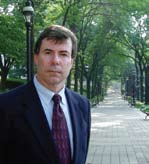With the silicon solar-cell industry growing by more than 40 percent a year, says Michael Stavola, scientists need better ways to neutralize defects in semiconductors.
Silicon is used in more than 90 percent of all solar cells for power modules, says Stavola, who chairs Lehigh’s physics department. Thin films composed of compounds of other semiconducting materials make up most of the rest.
Manufacturers of solar cells typically use a wafer made of multicrystalline silicon that is cheaper than the single-crystal silicon used in microchips. Multicrystalline silicon, however, has more defects, and greater amounts of carbon and other impurities, than does single-crystal silicon. These defects, which include grain boundaries and dangling bonds, reduce the ability of the solar cell to generate electricity.
Stavola has spent 25 years investigating defects in semiconductors and the ability of hydrogen to passivate those defects. His goal is to answer basic questions about the behavior of hydrogen in semiconductors, particularly in silicon solar-cell materials.
Ultimately, Stavola also hopes to neutralize one of the major obstacles to the wider use of solar energy – its price tag.
“It’s easy to make solar cells; the technology dates back to the 1950s,” he says. “But we have to be able to make solar cells as cheap to use as coal is.”
A critical coating
When a silicon solar cell is fabricated, a thin antireflection coating is added to facilitate the penetration and absorption of light into the silicon. This coating, which contains 20 percent hydrogen, is annealed when the solar cell is processed to make its metal contacts. During this process, the hydrogen diffuses from the coating into the silicon.
Inside the solar cell, defects in the silicon undermine the generation of electricity by causing electron-hole pairs that have been generated by exposure to sunlight to recombine. The hydrogen mitigates these defects, prolonging the lifetimes of the electron-hole pairs and restoring their contribution to the electric current.
“The manufacturers of solar cells are able to make hydrogen passivate the defects in the multicrystalline silicon, but without understanding what exactly is happening,” says Stavola.
Stavola, an experimental physicist, conducts vibrational spectroscopy experiments with a Fourier Transform Infrared Spectrometer. The vibrations of atoms offer clues to the atomic structure and chemistry of materials.
Stavola’s team is the first to observe and characterize the hydrogen that is introduced into silicon solar cells during fabrication. The group has also determined the concentration and penetration depth of the hydrogen and compared these criteria for various solar-cell processing methods.
Other questions remain. Which defects are passivated by the hydrogen? What effect do the defect reactions have on the silicon? How can these reactions be modeled to enable fabricators to optimize all the steps in the hydrogenation process?
“There are a lot of ways to get hydrogen to enter solar-cell materials,” says Stavola. “What we need is a low-cost strategy that works in conjunction with the processing of the cell.”
Stavola collaborates with Beall Fowler, professor emeritus of physics and a theoretician who calculates the atomic structures and vibrational properties of material defects. He also works with Ajeet Rohatgi, founder of the University Center for Excellence in Photovoltaics at Georgia Tech. And he has ties with the Technical University of Dresden, Texas Tech University, the University of Rome, the University of Pittsburgh and American Capital Energy.
Stavola has received funding from NSF, DOE and a consortium of solar-cell companies.

